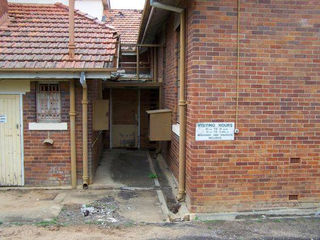

There Was Once an Asylum



This site not only provides an overview of mental health history and its implications for Goodna, but also explores the complex relationship between memory and history
There are stories we may never know, but this site uncovers the history, revealing the layers of understanding that form the foundation of the present.
It is done in a way that honours the patients, clients, and the people.
Osler House (Built 1928) & Pearce House (Built 1934)
Osler House and Pearce House are two almost identical, highly intact buildings standing in a line northeast of Noble House at the northern end of the Male Patients Area. Purpose-built as ward buildings for 'violent' or 'difficult' incarcerated male patients, they express their original use through architectural details and features designed for incarcerated patient management and reflect the principles of moral treatment.
Surrounded by open lawns, they face southeast toward the Recreation Grounds, and their primary access is on this side of the buildings.
In 2020 they are vacant and have had their bathrooms stripped out and original timber floors replaced by concrete.
Features of Osler House & Pearce House of state-level cultural heritage significance also include:
• Massing, form, construction: one-storey, lowset, freestanding brick structures with timber-framed front verandahs, floors, and partially steel-framed roofs (gable and hip)
• Symmetrical plan forms: front verandah; large central dining room with rear communal lavatory and boiler room block, flanked by a block on either side accommodating single patient rooms or large patient dormitory (Pearce House only), with narrow wings extending on either side accommodating single patient rooms accessed from the front verandah only
• Architectural detailing for incarcerated patient management (security, safety, hygiene, moral treatment): o orientation and views out from verandahs, dining rooms, and dormitories to the Recreation Ground and its cricket oval o efficient and logical room layouts; wards of dormitories and single rooms; communal ablutions for males only; centralised supplies stores; soiled clothes hatch in lavatory (blocked over) through to small storeroom accessed from rear o robust and cleanable/hygienic materials and finishes: polychrome face brick exterior walls and chimneys; concrete sills; terracotta wall vents; terracotta tile roof cladding with terracotta finials; timber batten eaves; gable apex infill of timber battens and roughcast render; plaster interior walls; concrete verandah floor and its red ochre surface staining; glazed ceramic wall tiles (kitchen, lavatory, and toilets); metal sheet-and-batten ceiling linings o measures for safety, security, and observation of patients: rounded and coved external and internal wall and floor corners; observation doors and windows; stable doors and their bracketed ledges; internal timber window shutters in patient rooms; wrought iron window grilles; wire mesh to lantern openings above patient rooms; openings in ceilings to provide recessed/secure lights; dining room fireplace and large windows; toilet cubicles without doors high levels of natural light and ventilation to the interior: spacious rooms with high ceilings; large windows and high-level windows; battened eaves; glazed and vented roof lanterns
• Original joinery: multi-paned double-hung windows, some with hinged sills allowing both sashes to slide down into wall pockets; internal doors (glazed and solid); original brass window and door hardware; moulded architraves and picture rails; board-lined verandah ceilings and valances • courtyards, their grassed open areas and concrete spoon drains and stairs
• One jacaranda tree east of Osler House (lone remnant of the avenue of jacarandas east of Osler and Pearce houses)
• One mature palm (unidentified spp.) in Pearce House courtyard
























